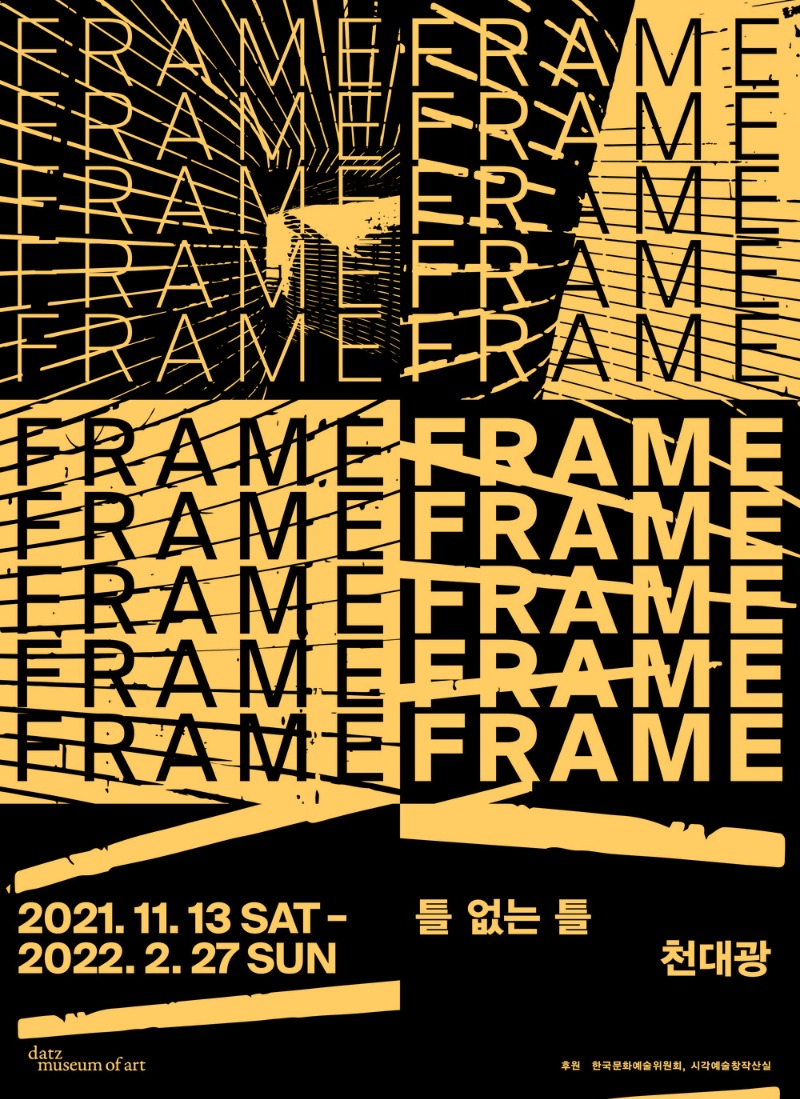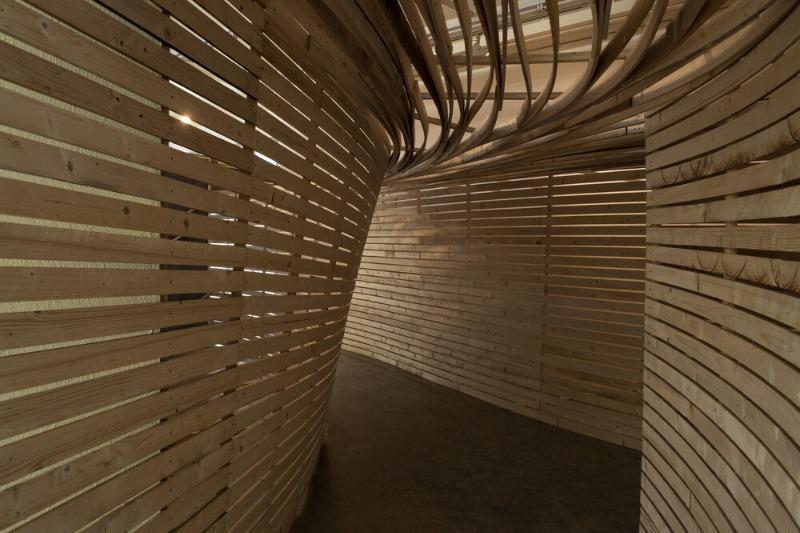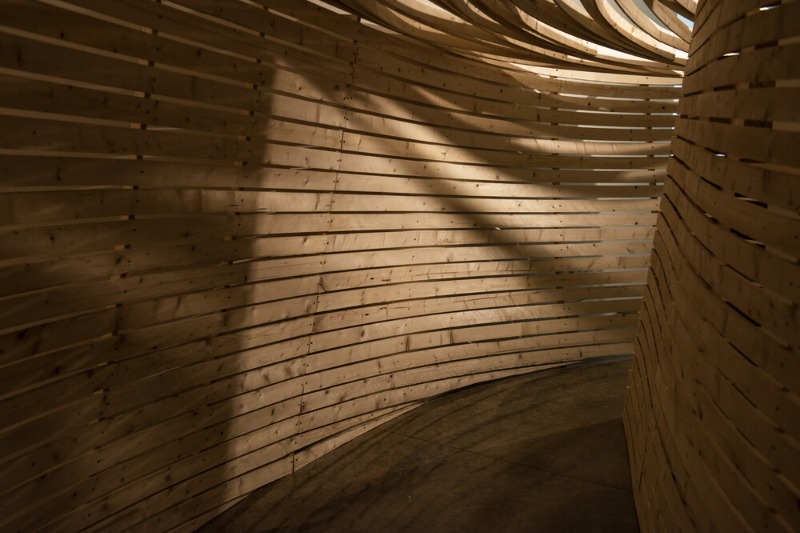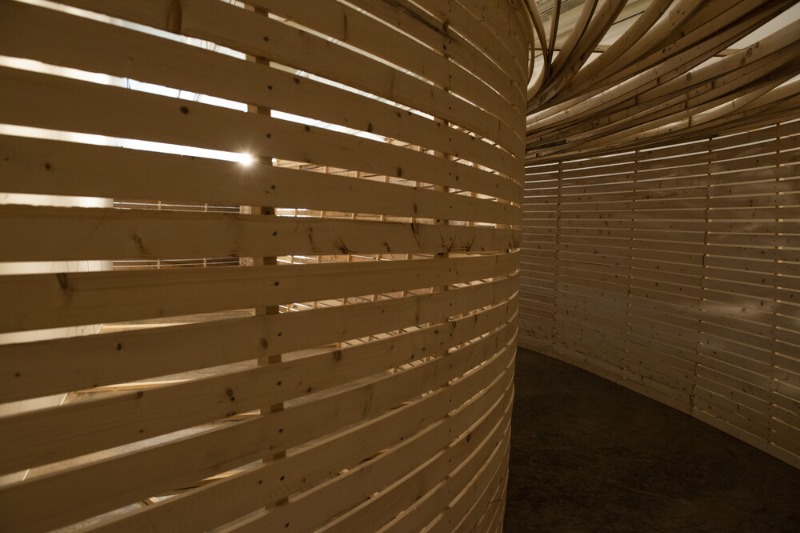
| Period| | 2021.11.13 - 2022.02.27 |
|---|---|
| Operating hours| | 11:00 - 18:00 |
| Space| | Gallery Datz/Gyeonggi |
| Address| | 184, Jinsaegol-gil, Chowol-eup, Gwangju-si, Gyeonggi-do, Republic of Korea |
| Closed| | Monday, Tuesday, Lunar New Year, Chuseok, Election Day |
| Price| | Free |
| Phone| | 070-4193-2581 |
| Web site| | 홈페이지 바로가기 |
| Artist| |
천대광
|
정보수정요청



|
|
Exhibition Information




Frame is the third and final exhibition of the year, planned within this year’s larger theme of “place and space.” The first exhibition began at “home” as the genesis of life, and the second exhibition told a story of a life “on the boundary,” traversing between the inside and outside, and the third exhibition attempts to capture the undefined meaning of a plane of existence within a frame created by points and lines. Installation artist Chen Dai Goang weaves a space out of wood following his senses and intuition, creating a structure that is unable to be defined nor recognized. The journey from home brings us to an open, abstract space that is empty, where the questions of art and life flow through it like music due to that very reason. We hope that Frame, installed at Datz Museum of Art, will provide a brief moment of reflection to look back through the spaces of one’s life. - The exhibition Frame looks at the significance of a “frame,” as the final installment of this year’s exhibition trilogy focusing on the themes of place and space in the perspectives of ‘Point (Home) - Line (On the Boundary) - Plane (Frame)’. Frame questions the borders which slip away the very moment they attempt to limit or define an existence or meaning of art. Having started out as a philosophical method of questioning life, art continues to take on different forms in limitless variations, into a world of the unknown. The frame acts as a fluid boundary between art and the world, channeling the circulation of our memories within the archetypal structures of time and space. Chen Dai Goang is an artist who embodies this idea, freely twisting and reconstructing the ins and outs of a frame in diverse spaces based on the organic ways of nature. His work maintains a subjective form of existence as autonomous and flexible forms made from the most fundamental materials of nature within an institution of rigid frameworks. The artist presents a layered intuition accumulated through his time of wandering through various spaces in the mountains, diverse topography, and architectural structures. The same perspectives and attitudes are represented in the exhibition Frame. Chen views the interior and exterior of Datz Museum of Art, and approaches it from various points of perspective along its boundaries. He says, “The shapes I want to make were already there, even before I invented them, and already exist in the malleability of the material in my hands. I work as the space teaches me and hammer according to the material’s guidance.” Left alone in an empty place, the artist opens himself to the given circumstances, and rides an improvised rhythm according to the spaces’ flow. Like a spider weaving its web, Chen begins working from a certain point that is intuitively chosen, gradually building a full structure made solely with wood. Individual planks are placed in an impromptu manner but eventually reveal an interwoven shape through time. The resulting twisting and turning structure is reminiscent of a narrow valley, with its fluctuations of widening and narrowing along the path of the museum’s “U”-shaped space. This space represents an open frame perceived from the artist’s perspective. The main material of wood serves as the background, while the second material of artificial light casts shadows that evoke the mental illusions of memory. The artist attempts to create a space where the spectators are the subject, immersing themselves in inner dialogue or meditation. This newly transformed exhibition space offers an unfamiliar encounter quite different from an ordinary museum experience: one of an open frame that is hard to define. It is our hope that as the viewers see the space created from distinct points of an empty room connected by lines that form planes, they also experience the perception of art expanding from individual perspectives to dimensions that transcend the frames of time and space. This “frame without frame” remains as a standing question concerning things whose forms we cannot define, though we can perceive and carry on, whether they be life or art. Lee Kwan Hoon - Chen Dai Goang graduated from the College of Arts at Dongguk University with a degree in Fine Arts. In 2006, he began studying at the Muenster Academy of Fine Arts in Germany, and finished his master’s program under professors Maik and Dirk Loebbert in 2007. Currently, he is living and working in the City Yangpyeong. Artist Chen Dai Goang has remained active across diverse mediums of expression, from sculpture to installation and architecture, and has delved into ways to create spaces open to artistic intervention and the realization of artistic ideas. Chen takes a site-specific approach and strategy by identifying the physical, spatial, and architectural features of the exhibition space; the topographic, geological, and natural environments of the location of the exhibition space; and sometimes the historical, social, and cultural context of the location. Such exhibition spaces encompass the so-called institutional spaces such as galleries and museums, outdoor spaces such as parks, and public spaces. This approach enables the artist to showcase structures created based on close studies on new exhibition spaces (i.e., House of Fireflies in 2007, Twisted Space in 2008, Grid Tunnel in 2009, Messenger in 2009, Dark Memories in 2011, Architectural Installation in 2011, Lost Horizon – Shangri-La in 2012, RPVC in 2013, Dreams of the Perfect City in 2021), where viewers can freely move around or stay put; where artworks and viewers, the exhibition space and the surrounding environment and structures, and the interior and the exterior can all interact; and where viewers can perceive and experience the exhibition space (architectural space) and its surroundings in a whole new perspective. In addition to his site-specific and site-dependent approach, the artist’s exploration of and experimentation on the space are realized by bringing together knowledge about architectural materials, aesthetic and emotional experiences and memories about both manmade and natural spaces, and references across different areas of the artist’s interest in diverse ways. Such an approach allows the artist to create a new inspiring space where his structures can stand and exist independently, rather than directly interfering with the physical, architectural conditions of the space, or to transform the entire exhibition space into a strange landscape. The best examples of such creations are Landscape (2010), House, Passage, and Exit (2013), and Guardian Tree (2015).
